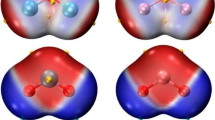Abstract
Interaction of bromine ions absorbed by water cluster with adsorbed oxygen and ozone molecules has been investigated by the molecular dynamics method. It was shown that the part of O2 molecules was removed from the system by evaporating Br− ions, while all O3 molecules and Br ions were kept in the system during 25 ps. The increase the concentration of the Br− ions in the clusters resulted in a reduction of the absorption intensity and emission in IR spectra at the presence of oxygen, whereas the absorption intensity in the appropriate IR spectra of ozone-containing systems increased with the growth of a number of the Br− ions. Raman spectra of oxygen-containing systems were poorly sensitive to the concentration of the Br− ions but the absorption intensity of Raman spectra for systems with ozone considerably decreased with the growth of a number of bromine ions.
Similar content being viewed by others
References
Galashev, A.E., Rakhmanova, O.R., Novruzova, O.A. and Galasheva, A.A., Kolloid. Zh., 2009, vol. 71, no. 6, p. 734.
Galashev, A.E., Rus. J. Phys. Chem. A., 2009, vol. 83, no. 13, p. 55.
Galashev, A.E., Rakhmanova, O.R. and Novruzova, O.A., Zh. Obshch. Khim., 2009, vol. 79, no. 9, p. 1409.
Dang, L.X. and Chang, T.-M., J. Chem. Phys., 1997, vol. 106, p. 8149.
Spackman, M.A., J. Chem. Phys., 1986, vol. 85, p. 6579.
Spackman, M.A., J. Chem. Phys., 1986, vol. 85, p. 6587.
Saint-Martin, H., Hess, B. and Berendsen, H.J.C., J. Chem. Phys., 2004, vol. 120, p. 11133.
Haile, J.M., Molecular dynamics simulation. Elementary methods, N.Y.-Chichester-Brisbane-Toronto-Singapore: John Wiley & Sons, Inc., 1992.
Koshlyakov, V.N., Zadachi dinamiki tverdogo tela i prikladnoj teorii giroskopov (Problems of Rigid Body Dynamics and Applied Theory of Gyroscopes), Moscow: Nauka, 1985.
Sonnenschein, R., J. Comp. Phys., 1985, vol. 59, p. 347.
Bresme, F., J. Chem. Phys., 2001, vol. 115, p. 7564.
Neumann, M., J. Chem. Phys., 1985, vol. 82, p. 5663.
Bosma, W.B., Fried, L.E. and Mukamel, S., J. Chem. Phys., 1993, vol. 98, p. 4413.
Landau, L.D. and Lifshits, E.M., Elektrodinamika sploshnyih sred (Electrodynamics of Continuous Media), Moscow: Nauka, 1982, vol. 8.
Fisicheskaya enziklopediya (Physical Encyclopedia), Ed. Prokhorov, A.M., Moscow: Sovetskaya Enziklopediya, 1988, vol. 1, p. 702.
Galashev, A.E., Rakhmanova, O.R. and Chukanov, V.N., Teplofiz. Vysok. Temp., 2009, vol. 47, no. 3, p. 360.
Galashev, A.E. and Rakhmanova, O.R., Zh. Obshch. Khim., 2008, vol. 78, no. 8, p. 1233.
Goggin, P.L. and Carr, C., Far Infrared Spectroscopy and Aqueous Solutions. Water and Aqueous Solutions, Bristol-Boston: Adam Hilger, 1986, vol. 37, p. 149.
Kozintsev, V.I., Belov, M.L., Gorodnichev, V.A. and Fedotov, Yu.V., Lazernyij optiko-akusticheskij analiz mnogokomponentnyih gazovyih smesej (Optical-and-Acoustic Laser Analysis of Multicomponent Gas Mixtures), Moscow: Izd. MGTU im. N.E. Baumana (Bauman Moscow State Technical Univ.), 2003, 352 p.
Potapova, G.F., Klochikhin, V.L., Putilov, A.V., Kasatkin, E.V. and Kozlova, N.V., Abstr. I Vserossijskaya Konferentsiya “Ozon i drugie ekologicheski chistyie okisliteli. Nauka i tehnologiya”, Moscow: Izd. Mosk. Gos. Univ., 2005.
Upschulte, B.L., Green, B.D., Blumberg, W.A. and Lipson, S.J., J. Phys. Chem., 1994, vol. 98, p. 2328.
Vallee, P., Lafait, J., Ghomi, M., Jouanne, M. and Morhange, J.F., J. Molec. Struct., 2003, vol. 651–653, p. 371.
Goldschleger, I. U., Kerenskaya, G., Janda, K. C. and Apkarian, V. A., J. Phys. Chem., A., 2008, vol. 112, p. 787.
Andrews, L. and Spiker, R.C. Jr., J. Phys. Chem., 1972, vol. 76, p. 3208.
Mausbach, P., Schnitker, J. and Geiger, A., J. Tech. Phys., 1987, vol. 28, p. 67.
Author information
Authors and Affiliations
Additional information
Original Russian Text © A.E. Galashev, 2010, published in Ekologicheskaya Khimiya, 2010, Vol. 19, No. 2, pp. 65–74.
Alexader Yevgenjevich Galashev, D. phis.-math., the main scientist at the Institute of Industrial Ecology, Ural Branch, Russian Academy of Sciences. Area of research interests: chemical aspects of ecology and rational nature use.
Rights and permissions
About this article
Cite this article
Galashev, A.E. Cluster mechanism of the atmosphere ozone destruction by bromine ions. Russ J Gen Chem 81, 2625–2633 (2011). https://doi.org/10.1134/S1070363211130019
Received:
Published:
Issue Date:
DOI: https://doi.org/10.1134/S1070363211130019




